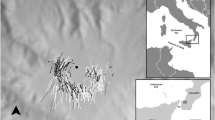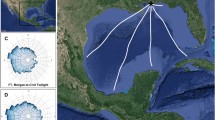Abstract
Many animals seasonally travel between their breeding and wintering grounds. With their advanced mobility, birds often migrate over thousands of kilometres. Recently, satellite-tracking studies have revealed peculiar migration routes for some avian species at a global scale. However, the adaptability of such migration routes has not been clearly demonstrated. Using satellite-tracking data for 33 individuals, we show that the Japanese population of Oriental honey-buzzards (Pernis ptilorhynchus) directly crosses the 650-km-wide East China Sea during their autumn migration, although they fly a longer route around the sea rather than directly crossing it during their spring migration. By applying aerodynamic theory, we show that the buzzards could cross the sea by soaring and gliding flight. Moreover, using a high-resolution meteorological-prediction analysis, we demonstrate that the migratory trajectory of the birds strongly depends on the wind direction at their estimated locations. In the area, northeastern tailwinds blow stably only during autumn. Thermals were abundant ca. 500–1,000 m over the East China Sea in autumn, but that was not the case in spring. We suggest that the autumn-migration route across the East China Sea is likely to have evolved in response to the specific weather conditions over the sea. Animations showing movements of Oriental honey-buzzards and temporal change in weather conditions are available at: http://www.momo-p.com/showdetail-e.php?movieid=momo110822oh01a, http://www.momo-p.com/showdetail-e.php?movieid=momo110822oh02a, http://www.momo-p.com/showdetail-e.php?movieid=momo110822oh04a, http://www.momo-p.com/showdetail-e.php?movieid=momo110822oh05a, http://www.momo-p.com/showdetail-e.php?movieid=momo110822oh06a, and http://www.momo-p.com/showdetail-e.php?movieid=momo110822oh07a.






Similar content being viewed by others
References
Alerstam T (2001) Detours in bird migration. J Theor Biol 209:319–331
Brazil M (1991) Birds of East Asia. Princeton University Press, Princeton
Chevallier D, Handrich Y, Georges J-Y, Baillon F, Brossault P, Aurouet A, Le Maho Y, Massemin S (2010) Influence of weather conditions on the flight of migrating black storks. Proc R Soc B 277:2755–2764
CLS (2008) Argos user’s manual: world wide tracking and environmental monitoring by satellite. CLS, Maryland
Egevang C, Stenhouse IJ, Phillips RA, Petersen A, Fox JW, Silk JRD (2010) Tracking of arctic terns Sterna paradisaea reveals longest animal migration. Proc Natl Acad Sci USA 107:2078–2081
Gill RE Jr, Tibbitts TL, Douglas DC, Handel CM, Mulcahy DM, Gottschalck JC, Warnock N, McCaffery BJ, Battley PF, Piersma T (2009) Extreme endurance flights by landbirds crossing the Pacific Ocean: ecological corridor rather than barrier? Proc R Soc B 276:447–458
Higuchi H (2010) Satellite tracking the migration of birds in eastern Asia. Br Birds 103:284–302
Higuchi H, Shiu H-J, Nakamura H, Uematsu A, Kuno K, Saeki M, Hotta M, Tokita K-I, Moriya E, Morishita E, Tamura M (2005) Migration of honey-buzzards Pernis apivorus based on satellite tracking. Ornithol Sci 4:109–115
Kondo J (1976) Heat balance of the East China Sea during the air mass transformation experiment. J Meteorol Soc Jpn 54:382–398
Leshem Y, Yom-Tov Y (1998) Routes of migrating soaring birds. Ibis 140:41–52
MacGregor GR, Nieuwolt S (1998) Tropical climatology: an introduction to the climates of the low latitudes, 2nd edn. Wiley, New York
Mandel JT, Bildstein KL, Bohrer G, Winkler DW (2008) Movement ecology of migration in turkey vultures. Proc Natl Acad Sci USA 105:19102–19107
Mandel J, Bohrer G, Winkler D, Barber D, Houston C, Bildstein K (2011) Migration path annotation: cross-continental study of migration-flight response to environmental conditions. Ecol Appl. doi:10.1890/10-1651.1 (published online early)
Mellone U, López-López P, Limiñana R, Urios V (2010) Water conditions promote route flexibility during open ocean crossing in a long-distance migratory raptor. Int J Biometeorol 55:463–468
Nakagawa M (1991) Outline of the high resolution global model. Jpn Meteorol Agency Tech Rev 11:1–13. http://www.jma.go.jp/jma/jma-eng/jma-center/rsmc-hp-pub-eg/techrev.htm
Newton I (2008) The migration ecology of birds. Academic Press, London
Pennycuick CJ (2001) Speeds and wingbeat frequencies of migrating birds compared with calculated benchmarks. J Exp Biol 204:3283–3294
Pennycuick CJ (2008) Modelling the flying bird. Academic Press, London
Saito K (2006) The operational JMA nonhydrostatic mesoscale model. Mon Weather Rev 134:1266–1298
Shamoun-Baranes J, Baharad A, Alpert P, Berthold P, Yon-Tov Y, Dvir Y, Leshem Y (2003) The effect of wind, season and latitude on the migration speed of white storks Ciconia ciconia, along the eastern migration route. J Avian Biol 34:97–104
Shamoun-Baranes J, Bouten W, van Loon EE (2010) Integrating meteorology into research on migration. Integr Comp Biol 50:280–292
Woodcock AH (1975) Thermals over the sea and gull flight behavior. Bound Layer Meteorol 9:63–68
Wyrtki K, Meyers G (1975) The trade wind field over the Pacific Ocean. J Appl Meteorol 15:698–704
Yamaguchi N, Tokita K-I, Uematsu A, Kuno K, Saeki M, Hiraoka E, Uchida K, Hotta M, Nakagawa F, Takahashi M, Nakamura H, Higuchi H (2008) The large-scale detoured migration route and the shifting pattern of migration in Oriental honey-buzzards breeding in Japan. J Zool 276:54–62
Acknowledgments
We thank K.-I. Tokita, K. Uchida, K. Kuno, M. Saeki, E. Hiraoka, N. Hijikata, F. Nakayama, T. Endo, Y. Nishizawa, M. Hotta, H. Nakamura and M. Takahashi and several others for their assistance in the field. C.J. Pennycuick gave comments on the aerodynamic analysis. This study was funded by the Ministry of the Environment in Japan.
Author information
Authors and Affiliations
Corresponding author
Electronic supplementary material
Below is the link to the electronic supplementary material.
10164_2011_301_MOESM2_ESM.mov
Movie 1 Animation showing movements of satellite-tracked Oriental honey-buzzards and the temporal change in the weather conditions in the area that includes the East China Sea, the Korea/Tsushima Strait, and the Korea Peninsula during the 2006-2008 autumn seasons. See also the legend of figure 4 in the main text (MOV 29702 kb)
10164_2011_301_MOESM3_ESM.mov
Movie 2 Animation showing movements of satellite-tracked Oriental honey-buzzards and the temporal change in the weather conditions in the area that includes the East China Sea, the Korea/Tsushima Strait, and the Korea Peninsula during the 2007-2009 spring seasons. See also the legend of figure 4 in the main text (MOV 25626 kb)
10164_2011_301_MOESM4_ESM.mov
Movie 3 Animation showing movements of satellite-tracked Oriental honey-buzzards and the temporal change in the estimated thermal energies of lower altitudes (200-600 m) in the area that includes the East China Sea, the Korea/Tsushima Strait, and the Korea Peninsula during the 2006-2008 autumn seasons. See also the legend of figure 5 in the main text (MOV 9135 kb)
10164_2011_301_MOESM5_ESM.mov
Movie 4 Animation showing movements of satellite-tracked Oriental honey-buzzards and the temporal change in the estimated thermal energies of higher altitudes (600-1000 m) in the area that includes the East China Sea, the Korea/Tsushima Strait, and the Korea Peninsula during the 2006-2008 autumn seasons. See also the legend of figure 5 in the main text (MOV 6095 kb)
10164_2011_301_MOESM6_ESM.mov
Movie 5 Animation showing movements of satellite-tracked Oriental honey-buzzards and the temporal change in the estimated thermal energies of lower altitudes (200-600 m) in the area that includes the East China Sea, the Korea/Tsushima Strait, and the Korea Peninsula during the 2007-2009 spring seasons. See also the legend of figure 5 in the main text (MOV 2306 kb)
10164_2011_301_MOESM7_ESM.mov
Movie 6 Animation showing movements of satellite-tracked Oriental honey-buzzards and the temporal change in the estimated thermal energies of higher altitudes (600-1000 m) in the area that includes the East China Sea, the Korea/Tsushima Strait, and the Korea Peninsula during the 2007-2009 spring seasons (MOV 2484 kb)
About this article
Cite this article
Yamaguchi, N.M., Arisawa, Y., Shimada, Y. et al. Real-time weather analysis reveals the adaptability of direct sea-crossing by raptors. J Ethol 30, 1–10 (2012). https://doi.org/10.1007/s10164-011-0301-1
Received:
Accepted:
Published:
Issue Date:
DOI: https://doi.org/10.1007/s10164-011-0301-1




